-

新人教版高中英语选修2Unit 4 Reading for writing教学设计
假定你是英国的Jack,打算来中国旅行,请你给你的中国笔友李华写一封信,要点如下:1.你的旅行计划:北京→泰山→杭州;2.征求建议并询问他是否愿意充当你的导游。注意:1.词数80左右(开头和结尾已给出,不计入总词数);2.可以适当增加细节,以使行文连贯。参考词汇:故宫 the Forbidden City;泰山 Mount TaiDear Li Hua,I'm glad to tell you that 'm going to visit China.First,I am planning to visit Beijing,the capitalof China,where I am looking forward to enjoying the Great Wall,the Forbidden City and somebeautiful parks.Then I intend to go to visit Mount Tai in Shandong Province.I've heard that it is one ofthe most famous mountains in China and I can't wait to enjoy the amazing sunrise there.After that,I amalso going to Hangzhou.It is said that it is a beautiful modern city with breathtaking natural sights,among which the West Lake is a well- known tourist attraction.What do you think of my travel plan? Will you act as my guide? Hope to hear from you soon.

新人教版高中英语选修2Unit 5 Reading and thinking教学设计
The theme of this activity is to learn the first aid knowledge of burns. Burns is common in life, but there are some misunderstandings in manual treatment. This activity provides students with correct first aid methods, so as not to take them for granted in an emergency. This section guides students to analyze the causes of scald and help students avoid such things. From the perspective of text structure and collaborative features, the text is expository. Expository, with explanation as the main way of expression, transmits knowledge and information to readers by analyzing concepts and elaborating examples. This text arranges the information in logical order, clearly presents three parts of the content through the subtitle, accurately describes the causes, types, characteristics and first aid measures of burns, and some paragraphs use topic sentences to summarize the main idea, and the level is very clear.1. Guide students to understand the causes, types, characteristics and first aid methods of burns, through reading2. Enhance students’ ability to deal withburnss and their awareness of burns prevention3. Enable students to improve the ability to judge the types of texts accurately and to master the characteristics and writing techniques of expository texts.Guide students to understand the causes, types, characteristics and first aid methods of burns, through readingStep1: Lead in by discussing the related topic:1. What first-aid techniques do you know of ?CPR; mouth to mouth artificial respiration; the Heimlich Manoeuvre

新人教版高中英语选修2Unit 5 Using langauge-Listening教学设计
The theme of this section is to learn how to make emergency calls. Students should learn how to make emergency calls not only in China, but also in foreign countries in English, so that they can be prepared for future situations outside the home.The emergency telephone number is a vital hotline, which should be the most clear, rapid and effective communication with the acute operator.This section helps students to understand the emergency calls in some countries and the precautions for making emergency calls. Through the study of this section, students can accumulate common expressions and sentence patterns in this context. 1.Help students accumulate emergency telephone numbers in different countries and learn more about first aid2.Guide the students to understand the contents and instructions of the telephone, grasp the characteristics of the emergency telephone and the requirements of the emergency telephone.3.Guide students to understand the first aid instructions of the operators.4.Enable Ss to make simulated emergency calls with their partners in the language they have learned1. Instruct students to grasp the key information and important details of the dialogue.2. Instruct students to conduct a similar talk on the relevant topic.Step1:Look and discuss:Match the pictures below to the medical emergencies, and then discuss the questions in groups.

新人教版高中英语必修3Unit 2 Morals and Virtues教学设计三
The joke set her crying.这个玩笑使她哭起来。Step 5 ReadingActivity 31. Students read the small text in activity 3. The teacher provides several small questions to check whether students understand the content of the text and the ideographic function of the -ing form in the text.*Where are those people?*Why did Dr Bethune come to China?*How did he help the Chinese people during the war?*What did Chairman Mao Zedong say about him?2. Ss try to rewrite some sentences using the -ing form. Then check the answers. When checking the answers, the teacher can ask different students to read the rewritten sentences and give comments.Answers:1. he became very interested in medicine, deciding to become a doctor.2. …after hearing that many people were dying in the war.3. Helping to organise hospitals, he taught doctors and nurses, and showed people how to give first aid./ He helped to organise hospitals, teaching doctors and nurses, and showing people how to give first aid.4. …praising Dr Bethune as a hero to be remembered in China.Step 6 PracticeActivity 4Students complete grammar activities 2 and 3 on page 69 of the workbook.Step 6 Homework1. Understand and master the functions and usage of the -ing form;2. Finish the other exercises in Using structures.1、通过本节内容学习,学生是否理解和掌握动词-ing形式作宾语补足语语和状语语的功能和意义;2、通过本节内容学习,学生能否正确使用动词-ing形式描述人物的行为、动作及其经历;3、通过本节内容学习,学生能否独立完成练习册和导学案中的相关练习。

新人教版高中英语必修3Unit 2 Morals and virtues教学设计一
(2) students are divided into groups according to the requirements of activity 3. Each student shares a story of personal experience or hearing-witnessing kindness, and then selects the most touching story in the group and shares it with the whole class. Before the students share the story, the teacher can instruct them to use the words and sentence patterns in the box to express. For example, the words in the box can be classified:Time order: first of all, then, after that, later, finally logical relationship :so, however, although, butTeachers can also appropriately add some transitional language to enrich students' expression:Afterwards, afterwards, at last, in the end, eventuallySpatial order: next to, far from, on the left, in front ofOtherwise, nevertheless, as a result, therefore, furthermore, in addition, as well asSummary: in a word, in short, on the whole, to sum up, in briefStep 8 Homework1. Understand the definition of "moral dilemma" and establish a correct moral view;2. Accumulate vocabulary about attitudes and emotions in listening texts and use them to express your own views;3. Complete relevant exercises in the guide plan.1、通过本节内容学习,学生能否理解理解“道德困境”的定义;2、通过本节内容学习,学生能否通过说话人所表达的内容、说话的语气、语调等来判断其态度和情绪;3、通过本节内容学习,学生能否针对具体的道德困境发表自己的看法和见解,能否掌握听力理训练中的听力策略。
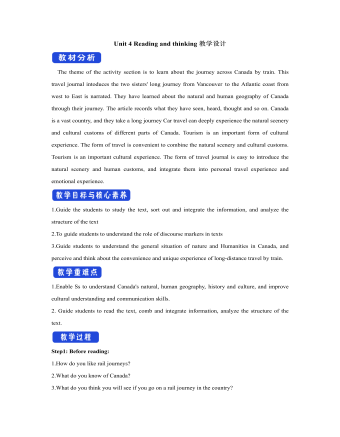
新人教版高中英语选修2Unit 4 Reading and thinking教学设计
【词汇精讲】highlight n.最好或最精彩的部分 vt.突出;强调;使醒目One of the highlights of the trip was seeing the Taj Mahal.这次旅行的亮点之一是参观泰姬陵。Your resume should highlight your skills and achievements.你的简历应该突出你的技能和成就。The report highlights the major problems facing society today.报告强调了当今社会所面临的主要问题。I’ve highlighted the important passages in yellow.我用黄色标出了重要段落。7.Edmonton is freezing cold in winter,with daily temperatures averaging -10 ℃.埃德蒙顿冬季寒冷,日平均气温为-10°C。【词汇精讲】freezing adj.极冷的;冰冻的Leave a basin of water outside in freezing weather.在冰冻的天气里,放一盆水在室外。It’s freezing cold outside so wear a warm coat.外面超冷的,所以穿一个暖和一点的外套吧。8.It was not until 9:30 a.m.that they finally reached the capital of Ontario,Toronto.直到上午9时30分,他们才终于到达多伦多的首府安大略省。【句式剖析】本句是一个强调句,强调的是句子的时间状语until 9:30。含有not...until...的句子的强调句为It is not until...that...,that后面的句子要用肯定形式。It was not until then that I suddenly realized nobody was happier than I was.直到那时我才突然意识到没有人比我更幸福了。
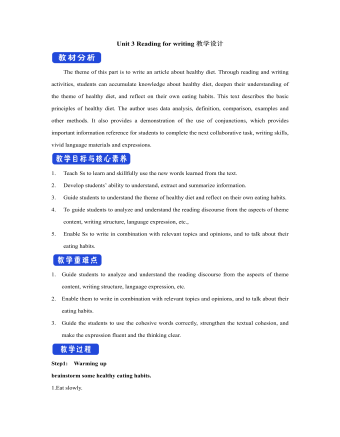
新人教版高中英语选修2Unit 3 Reading for writing教学设计
The theme of this part is to write an article about healthy diet. Through reading and writing activities, students can accumulate knowledge about healthy diet, deepen their understanding of the theme of healthy diet, and reflect on their own eating habits. This text describes the basic principles of healthy diet. The author uses data analysis, definition, comparison, examples and other methods. It also provides a demonstration of the use of conjunctions, which provides important information reference for students to complete the next collaborative task, writing skills, vivid language materials and expressions.1. Teach Ss to learn and skillfully use the new words learned from the text.2. Develop students’ ability to understand, extract and summarize information.3. Guide students to understand the theme of healthy diet and reflect on their own eating habits.4. To guide students to analyze and understand the reading discourse from the aspects of theme content, writing structure, language expression, etc., 5. Enable Ss to write in combination with relevant topics and opinions, and to talk about their eating habits.1. Guide students to analyze and understand the reading discourse from the aspects of theme content, writing structure, language expression, etc.2. Enable them to write in combination with relevant topics and opinions, and to talk about their eating habits.3. Guide the students to use the cohesive words correctly, strengthen the textual cohesion, and make the expression fluent and the thinking clear.Step1: Warming upbrainstorm some healthy eating habits.1.Eat slowly.2.Don’t eat too much fat or sugar.3.Eat healthy food.4.Have a balanced diet.Step2: Read the passage and then sum up the main idea of each paragraph.

新人教版高中英语选修2Unit 4 Using langauge-Listening教学设计
The theme of the listening section is " talking about scenery and culture along a journey."The part is designed to further lead the students to understand Canadian natural geography and social environment, and integrated into the cultural contrast by mentioning the long train journey from Beijing to Moscow routes. On this basis, the part activates students related travel experience, lets the student serial dialogue, guides the student to explore further the pleasure and meaning of the long journey, and Chinese and foreign cultural comparison.The part also provides a framework for the continuation of the dialogue, which is designed to provide a framework for students to successfully complete their oral expressions, and to incorporate an important trading strategy to end the dialogue naturally.1. Help students to understand and master some common English idioms in the context, and experience the expression effect of English idioms.2. Guide the students to understand the identity of different people in the listening context, and finish the dialogue according to their own experience.3. Instruct the students to use appropriate language to express surprise and curiosity about space and place in the dialogue, and master the oral strategy of ending the dialogue naturally.1. Instruct students to grasp the key information and important details of the dialogue.2. Instruct students to conduct a similar talk on the relevant topic.

新人教版高中英语选修2Unit 5 Learning about Language教学设计
The purpose of this section of vocabulary exercises is to consolidate the key words in the first part of the reading text, let the students write the words according to the English definition, and focus on the detection of the meaning and spelling of the new words. The teaching design includes use English definition to explain words, which is conducive to improving students' interest in vocabulary learning, cultivating their sense of English language and thinking in English, and making students willing to use this method to better grasp the meaning of words, expand their vocabulary, and improve their ability of vocabulary application. Besides, the design offers more context including sentences and short passage for students to practice words flexibly.1. Guide students to understand and consolidate the meaning and usage of the vocabulary in the context, 2. Guide the students to use the unit topic vocabulary in a richer context3. Let the students sort out and accumulate the accumulated vocabulary, establishes the semantic connection between the vocabulary,4. Enable students to understand and master the vocabulary more effectivelyGuiding the Ss to use unit topic words and the sentence patterns in a richer context.Step1: Read the passage about chemical burns and fill in the blanks with the correct forms of the words in the box.

新人教版高中英语必修3Unit 2 Morals and Virtues教学设计二
Activity 41. Students complete the task of activity 4, then teachers and students check the answers. 2. The teacher organized the students to work together and asked them to use the tables and mind maps sorted out before to retold the important choices in Lin Qiaozhi's life and their resultsStep 5 Language points1. The teacher asks the students to read the text carefully, find out the core words and long and difficult sentences in the text and draw lines, understand the use of vocabulary, and analyze the structure of long and difficult sentences. 2. The teacher explains and summarizes the usage of core vocabulary and asks the students to take notes. 3. The teacher analyzes and explains the long and difficult sentences that the students don't understand, so that the students can understand them better. Step 6 Homework1. Read the text again, in-depth understanding of the text; 2. Master the use of core vocabulary and understand the long and difficult sentences. 3. Complete relevant exercises in the guide plan. 1、通过本节内容学习,学生是否理解和掌握阅读文本中的新词汇的意义与用法;2、通过本节内容学习,学生能否结合文本特点总结林巧稚的人生原则和人格品质特征;3、通过本节内容学习,学生能否针对人生抉择发表自己的看法;能否全面地、客观地、理性地看待问题,进而对道德和人性有更加深入的思考和理解。
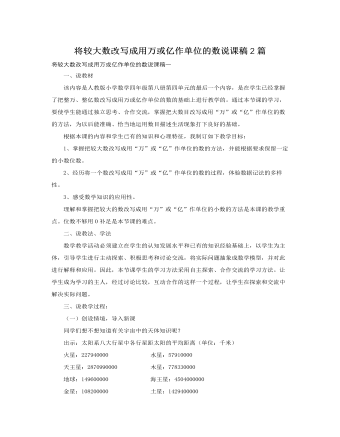
人教版新课标小学数学四年级下册将较大数改写成用万或亿作单位的数说课稿2篇
一、说教材该内容是人教版小学数学四年级第八册第四单元的最后一个内容,是在学生已经掌握了把整万、整亿数改写成用万或亿作单位的数的基础上进行教学的。通过本节课的学习,要使学生能通过独立思考、合作交流,掌握把大数目改写成用“万”或“亿”作单位的数的方法,为以后能准确、恰当地运用数目描述生活现象打下良好的基础。根据本课的内容和学生已有的知识和心理特征,我制订如下教学目标:1、掌握把较大数改写成用“万”或“亿”作单位的数的方法,并能根据要求保留一定的小数位数。2、经历将一个数改写成用“万”或“亿”作单位的数的过程,体验数据记法的多样性。3、感受数学知识的应用性。理解和掌握把较大的数改写成用“万”或“亿”作单位的小数的方法是本课的教学重点。位数不够用0补足是本节课的难点。
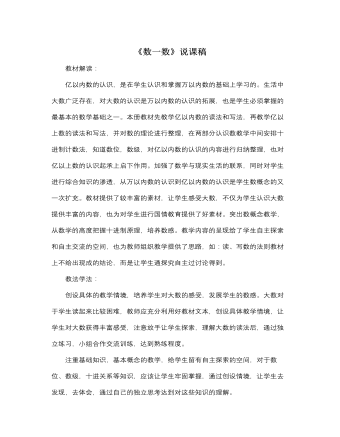
北师大版小学数学四年级上册《数一数》说课稿
亿以内数的认识,是在学生认识和掌握万以内数的基础上学习的。生活中大数广泛存在,对大数的认识是万以内数的认识的拓展,也是学生必须掌握的最基本的数学基础之一。本册教材先教学亿以内数的读法和写法,再教学亿以上数的读法和写法,并对数的理论进行整理,在两部分认识数教学中间安排十进制计数法,知道数位,数级,对亿以内数的认识的内容进行归纳整理,也对亿以上数的认识起承上启下作用。加强了数学与现实生活的联系,同时对学生进行综合知识的渗透,从万以内数的认识到亿以内数的认识是学生数概念的又一次扩充。教材提供了较丰富的素材,让学生感受大数,不仅为学生认识大数提供丰富的内容,也为对学生进行国情教育提供了好素材。突出数概念教学,从数学的高度把握十进制原理,培养数感。教学内容的呈现给了学生自主探索和自主交流的空间,也为教师组织教学提供了思路,如:读、写数的法则教材上不给出现成的结论,而是让学生通探究自主过讨论得到。
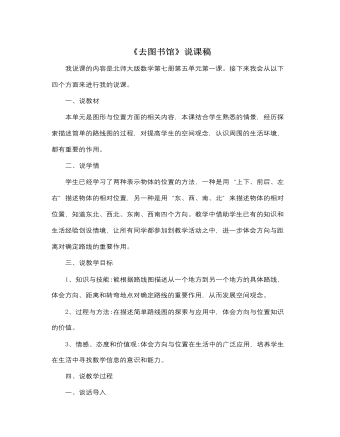
北师大版小学数学四年级上册《去图书馆》说课稿
一、说教材本单元是图形与位置方面的相关内容,本课结合学生熟悉的情景,经历探索描述简单的路线图的过程,对提高学生的空间观念,认识周围的生活环境,都有重要的作用。二、说学情学生已经学习了两种表示物体的位置的方法,一种是用“上下、前后、左右”描述物体的相对位置,另一种是用“东、西、南、北”来描述物体的相对位置,知道东北、西北、东南、西南四个方向。教学中借助学生已有的知识和生活经验创设情境,让所有同学都参加到教学活动之中,进一步体会方向与距离对确定路线的重要作用。三、说教学目标1、知识与技能:能根据路线图描述从一个地方到另一个地方的具体路线,体会方向、距离和转弯地点对确定路线的重要作用,从而发展空间观念。2、过程与方法:在描述简单路线图的探索与应用中,体会方向与位置知识的价值。3、情感、态度和价值观:体会方向与位置在生活中的广泛应用,培养学生在生活中寻找数学信息的意识和能力。
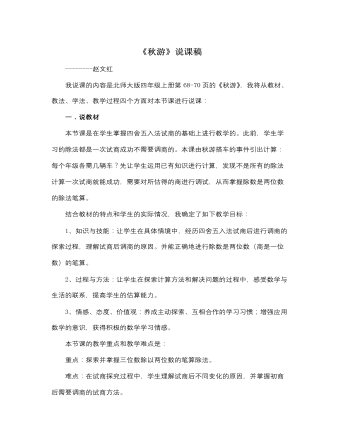
北师大版小学数学四年级上册《秋游》说课稿
我说课的内容是北师大版四年级上册第68-70页的《秋游》,我将从教材、教法、学法、教学过程四个方面对本节课进行说课:一.说教材本节课是在学生掌握四舍五入法试商的基础上进行教学的。此前,学生学习的除法都是一次试商成功不需要调商的。本课由秋游搭车的事件引出计算:每个年级各需几辆车?先让学生运用已有知识进行计算,发现不是所有的除法计算一次试商就能成功,需要对所估得的商进行调试,从而掌握除数是两位数的除法笔算。结合教材的特点和学生的实际情况,我确定了如下教学目标:1、知识与技能:让学生在具体情境中,经历四舍五入法试商后进行调商的探索过程,理解试商后调商的原因。并能正确地进行除数是两位数(商是一位数)的笔算。2、过程与方法:让学生在探索计算方法和解决问题的过程中,感受数学与生活的联系,提高学生的估算能力。
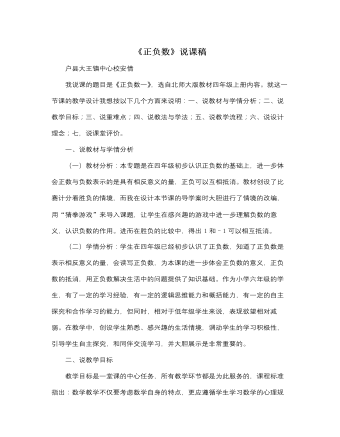
北师大版小学数学四年级上册《正负数》说课稿
二、说教学目标教学目标是一堂课的中心任务,所有教学环节都是为此服务的,课程标准指出:数学教学不仅要考虑数学自身的特点,更应遵循学生学习数学的心理规律??使学生获得对数学理解的同时,在思维能力、情感态度与价值观等方面都得到进步和发展。根据这一要求和本节教学内容,并结合学生的实际情况,本节课我确定如下学习目标:1、知识与技能在熟悉的生活情景中,进一步体会负数的意义;会用负数表示一些日常生活中的问题,知道正负可以相互抵消。2、过程与方法本节课以小组合作学习为主,让学生利用导学案自学,再对学、群学,最后在班里进行展示。整节课都是学生自主学习,积极探索的一个过程。3、情感、态度与价值观经历独学、交流、合作、展示等一系列活动,通过生生、师生互动获得良好的情感体验,同时让学生感受到了数学在生活中的应用。依据这样的教学目标,再结合学生的年龄特点,我运用了浅显易懂的儿童语言制定了导学案上的学习目标。
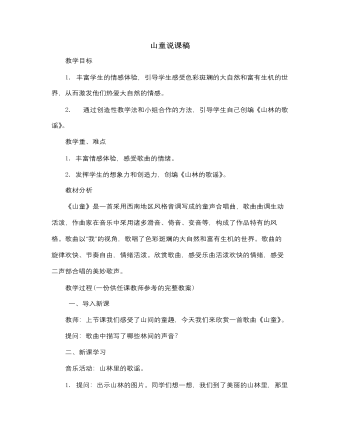
人音版小学音乐四年级上山童说课稿
三、欣赏合唱歌曲《山童》1. 教师:山林里不仅有自然的声音,还有山童的歌声呢!欣赏《山童》动画。2. 提问:这首歌曲是什么演唱形式?什么情绪?歌曲有什么特点?学生回答。3. 教师总结:这首歌曲是一首具有西南地区风格音调的童声合唱,歌曲的曲调生动活泼,加入了滑音、倚音、变化音等,构成了这首歌曲特有的风格。4. 播放《山童》音频。听到合唱部分随音乐轻轻晃动身体。教师指导:指导学生感受童声合唱音色的和谐,感受歌曲自由、活泼的情绪。四、课堂小结 今天我们不仅用自己创编的声音表现了大自然的美妙,还欣赏了动听的歌曲,歌曲歌唱了色彩斑斓的大自然和富有生机的世界,希望我们大家都能够感受到大自然对我们唱出的美妙歌声。
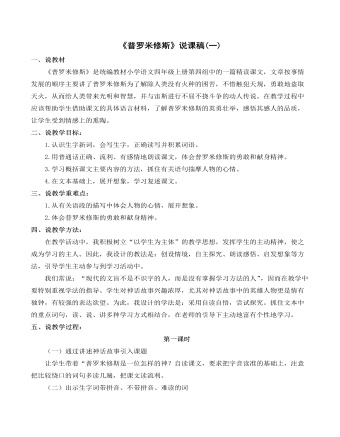
(新)部编人教版四年级上册《普罗米修斯》说课稿(一)
四、说教学方法: 在教学活动中,我积极树立“以学生为主体”的教学思想,发挥学生的主动精神,使之成为学习的主人。因此,我设计的教法是:创设情境,自主探究、朗读感悟、启发想象等方法,引导学生主动参与到学习活动中。 我们常说:“现代的文盲不是不识字的人,而是没有掌握学习方法的人”,因而在教学中要特别重视学法的指导。学生对神话故事兴趣浓厚,尤其对神话故事中的英雄人物更是情有独钟,有较强的表达欲望。为此,我设计的学法是:采用自读自悟,尝试探究。抓住文本中的重点词句,读、说、讲多种学习方式相结合,在老师的引导下主动地富有个性地学习。
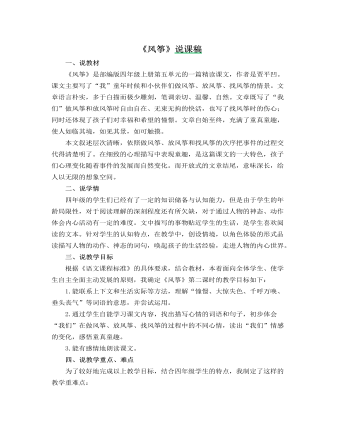
(新)部编人教版四年级上册《风筝》说课稿
六、说教学流程良好的教学设想必须通过教学实践来完成的,本课我预设两课时完成:第一课时:学习生字,初读课文,感知课文的主要内容,初步体会“我们”心情的变化。第二课时:感悟课文,体会“我们”“做风筝、放风筝、找风筝”时的心情变化,感悟童真童趣。我本次说课的内容是第二课时的教学。(一)复习导入1.听写词语:风筝 蝴蝶 拔几根 幸福 托着 垂头丧气 半圈树梢 歇一歇 千呼万唤 踪影 磨坊2. 这课文写出了作者童年做风筝放风筝时的快乐的情景。这节课让我们细细体会其中的快乐。(板书:风筝)(设计理念:由回忆放风筝的情景,引入课题,既锻炼了学生的表达能力,又勾起了他们美好的回忆,再次感受放风筝给他们带来的乐趣。让学生在已有生活经验基础上构建知识,使学生在不知不觉中感悟,培养学生在面对新知时,能主动寻找其现实背景的能力,激发了学生学习的积极性。)
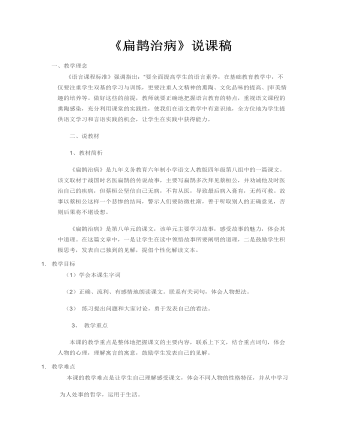
(新)部编人教版四年级上册《故事二则》说课稿(二)
一、教学理念《语言课程标准》强调指出:“要全面提高学生的语言素养,在基础教育教学中,不仅要注重学生双基的学习与训练,更要注重人文精神的熏陶、文化品味的提高、|审美情趣的培养等。做好这些的前提,教师就要正确地把握语言教育的特点,重视语文课程的熏陶感染,充分利用课堂的实践性,使我们在语文教学中有意识地,全方位地为学生提供语文学习和言语实践的机会,让学生在实践中获得能力。二、说教材1、教材简析《扁鹊治病》是九年义务教育六年制小学语文人教版四年级第八组中的一篇课文。该文取材于战国时名医扁鹊的传说故事,主要写扁鹊多次拜见蔡桓公,并劝诫他及时医治自己的疾病,但蔡桓公坚信自己无病,不肯从医,导致最后病入膏肓,无药可救。故事以蔡桓公这样一个悲惨的结局,警示人们要防微杜渐,善于听取别人的正确意见,否则后果将不堪设想。
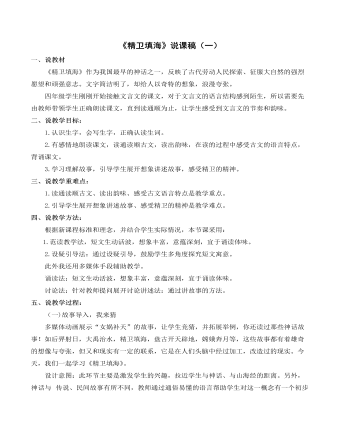
(新)部编人教版四年级上册《精卫填海》说课稿(一)
四、说教学方法: 根据新课程标准和理念,并结合学生实际情况,本节课采用: 1.范读教学法,短文生动活波,想象丰富,意蕴深刻,宜于诵读体味。2.设疑引导法:通过设疑引导,鼓励学生多角度探究短文寓意。此外我还用多媒体手段辅助教学。诵读法:短文生动活波,想象丰富,意蕴深刻,宜于诵读体味。讨论法:针对教师提问展开讨论讲述法:通过讲故事的方法。五、说教学过程:(一)故事导入,我来猜多媒体动画展示“女娲补天”的故事,让学生竞猜,并拓展举例,你还读过那些神话故事!如后羿射日,大禹治水,精卫填海,盘古开天辟地,嫦娥奔月等,这些故事都有着雄奇的想像与夸张,但又和现实有一定的联系,它是在人们头脑中经过加工,改造过的现实。今天,我们一起学习《精卫填海》。 设计意图:此环节主要是激发学生的兴趣,拉近学生与神话、与山海经的距离。另外,神话与 传说、民间故事有所不同,教师通过通俗易懂的语言帮助学生对这一概念有一个初步的认识,再自然引出课题。